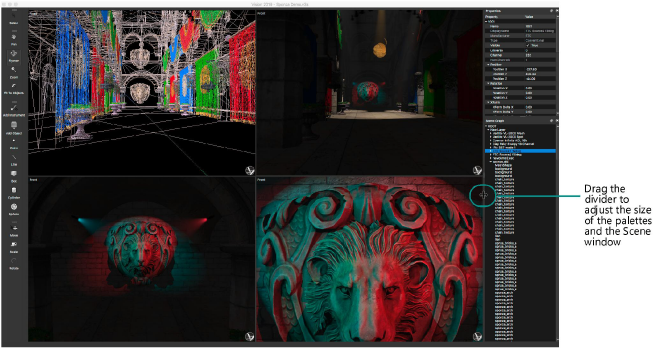
Command |
Path |
Shortcut |
Toggle Number of Viewports |
Window |
M |
The scene file contains the geometry that represents fixtures, trusses, pipes, set pieces, venue walls, and so on. The Scene window displays the scene file, and it is where visualization occurs.
Drag the divider along the edge of the Scene window to adjust the amount of space taken up by the Scene window and any open palettes.

The Scene window can be viewed as a single viewport or as four viewports, each with a different view.
To toggle the number of viewports in the Scene window:
Select the command.
Command |
Path |
Shortcut |
Toggle Fullscreen |
Window |
● Ctrl+Shift+F (Windows) ● Cmd+Shift+F (Mac) |
The Toggle Fullscreen command toggles between a maximized full screen of the bottom right viewport and the normal, resizable display of the Vision program.
To switch to full screen view:
Select the command.
The bottom right viewport expands, filling the entire screen.
To exit full screen view, press the Esc key, or press the keyboard shortcut again.
Luminance adaptation is simulated within Vision. For example, when a blackout occurs, the ambient light level automatically adjusts after a period of time to realistically replicate the reaction of a human eye viewing the scene. Conversely, the ambient level appears to dim when bright lighting is enabled within the scene.
The ambient lighting can be adjusted manually using keyboard shortcuts, or by modifying the Ambient Intensity on either the Document Preferences: General Tab or the Properties palette; see Selecting Global Scene Parameters, Objects, and Fixtures.
To increase the ambient light level by 1 using keyboard shortcuts, press Ctrl+Shift+L (Windows) or Cmd+Shift+L (Mac); to decrease the ambient light level by 1, press Ctrl+Shift+K (Windows) or Cmd+Shift+K (Mac).
To simulate the use of house lights, press Ctrl+Shift+J (Windows) or Cmd+Shift+J (Mac) to toggle them. If the Ambient Intensity is currently less than 50, the toggle increases the setting by 50. If the Ambient Intensity is 50 or more, the toggle decreases the setting by 50.
Command |
Path |
Shortcut |
Toggle Looked At Point |
Window |
● Ctrl+Shift+O (Windows) ● Cmd+Shift+O (Mac) |
Each viewport in the Scene window includes a Looked At point, which indicates where the camera is looking. The Looked At point affects all zooming and rotation operations, including the center of rotation for the Flyover tool. Use the tools in the Camera tool set to move the Looked At point. The Push Looked At Distance parameter on the Vision Preferences: Interactive Tab sets the minimum distance from the camera to the Looked At point. This distance can be adjusted to optimize close-ups or distant views.
To toggle the Looked At point on and off, select the command.

Each viewport in the Scene window can display in one of nine preset views, or in a custom view that can be saved (see Saving User Views). The label in the top left corner of the viewport indicates the current view; “User” designates either a custom view or one of the isometric preset views.
The six standard preset views can be accessed from the viewport context menu; right-click on the viewport and select one of the views. Alternatively, use the shortcut keys on the numeric keypad to access the standard and isometric views. Isometric views are labeled as User views.
 Click
to show/hide the parameters.
Click
to show/hide the parameters.
Each viewport can also display as solid or wireframe, and in orthographic or perspective projection.
To set the rendering and projection of a viewport:
Right-click on the viewport and select one of the commands from the context menu:
● Wireframe
● Solid
● Orthographic
● Perspective
A custom view (labeled “User”) can be saved and restored later. Up to nine Scene window views can be saved. The views are saved with the file. Use the keyboard numbers for these operations; do not use the numeric keypad, which controls the Scene Window Standard Views.
To save a view:
Click the viewport with the view to save.
Press the Ctrl key (Windows) or Cmd key (Mac), and any number key (1–9) on the keyboard.
The current viewport view settings are saved to the keyboard shortcut.
To restore a view:
Press the designated number key (1–9) to restore the saved view.
If the saved views do not display as expected, they can be reset. To reset all views:
Right-click on the viewport and select Set Default Views from the context menu. The saved views are replaced with the standard preset views.
~~~~~~~~~~~~~~~~~~~~~~~~~